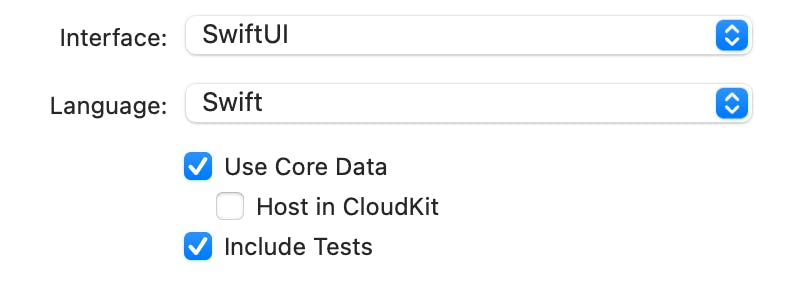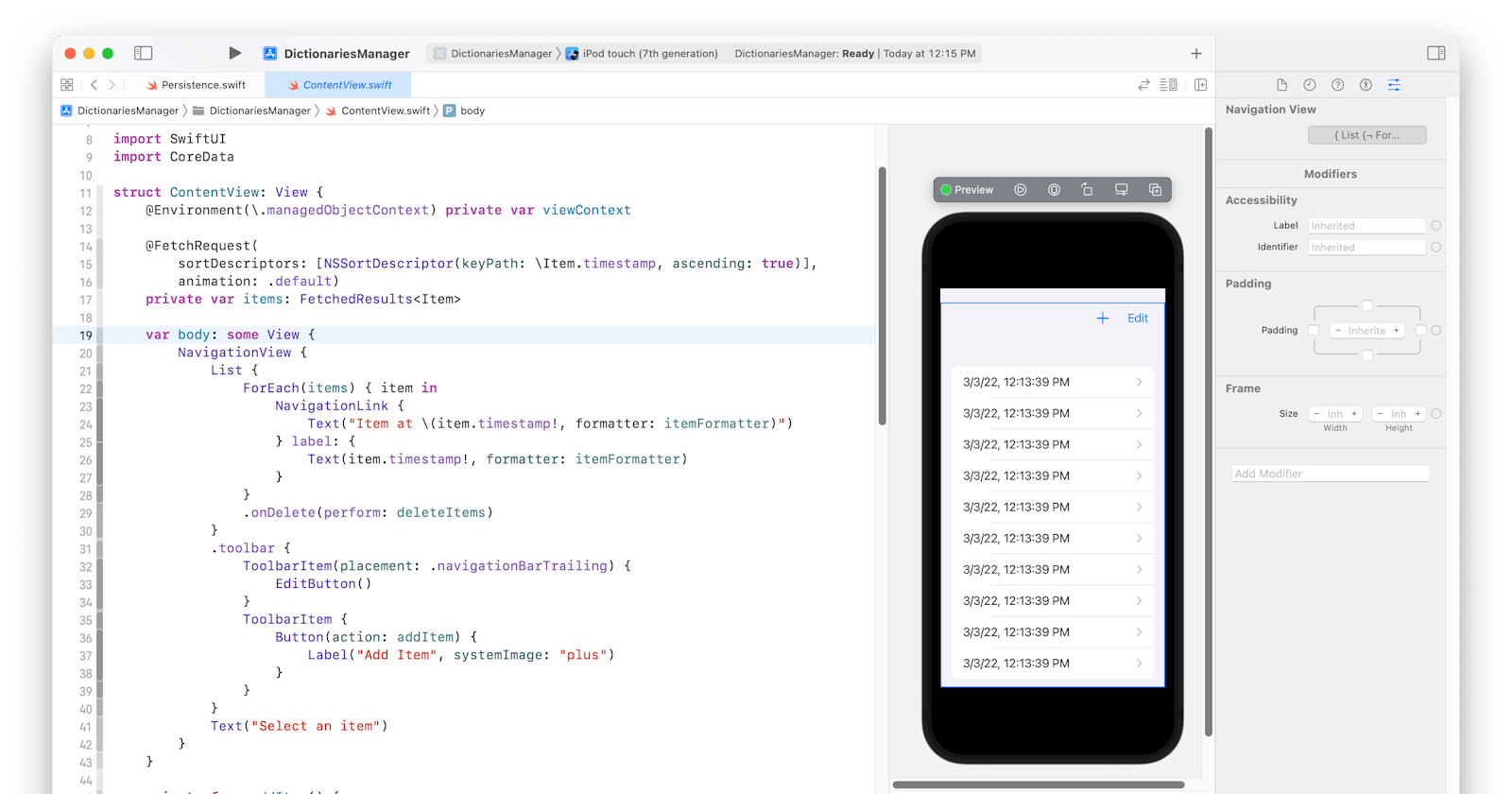之前我一直使用Realm来做数据存储,从上手来讲半小时就可以将Realm非常良好的运用于你的项目当中。正值我有一个假期,所以咬牙决定尝试下CoreData,实话说真的需要耐心和不断的尝试,这东西经历多年,被果子上万工程师来回补丁着实不易。写这个小纸条记录一下踩过的坑,应该会一直记录到CloudKit。坑已经挖在这里了,慢慢记录吧。对于CoreData我感觉在接下来的Xcode中还会不断的改进,现在明显还有不少临时手段,这系列小纸条均基于Swift 5.5, iOS 15, Xcode 13 。
创建项目
如果你的项目之前没有包括CoreData相关的内容,加起来还是比较容易的,但是如果你是新的项目,我还是比较喜欢项目模板中有关CoreData的代码。创建项目时可以勾选上CoreData:

如果同时勾选上Host in CloudKit你会发现代码只是Presitence不同,剩下的完全一样。这里我并没有勾选这个选项,等到CloudKit系列时再考虑这些。创建好的项目会自动生成有关CoreData的系列文件,如下图:

CoreData模板说明
DictionariesManager.xcdatamodeld
这是一个图形化的建模工具,预先为你创建好了一个示例Entity,名称为Item。

Persistence.swift
这个文件非常关键,我认为改一点之后就可以直接放在生产环境里使用。看过有朋友发的老版本的模板,确实非常不完善。
import CoreData
struct PersistenceController {
static let shared = PersistenceController()
static var preview: PersistenceController = {
let result = PersistenceController(inMemory: true)
let viewContext = result.container.viewContext
for _ in 0..<10 {
let newItem = Item(context: viewContext)
newItem.timestamp = Date()
}
do {
try viewContext.save()
} catch {
// Replace this implementation with code to handle the error appropriately.
// fatalError() causes the application to generate a crash log and terminate. You should not use this function in a shipping application, although it may be useful during development.
let nsError = error as NSError
fatalError("Unresolved error \(nsError), \(nsError.userInfo)")
}
return result
}()
let container: NSPersistentContainer
init(inMemory: Bool = false) {
container = NSPersistentContainer(name: "DictionariesManager")
if inMemory {
container.persistentStoreDescriptions.first!.url = URL(fileURLWithPath: "/dev/null")
}
container.viewContext.automaticallyMergesChangesFromParent = true
container.loadPersistentStores(completionHandler: { (storeDescription, error) in
if let error = error as NSError? {
// Replace this implementation with code to handle the error appropriately.
// fatalError() causes the application to generate a crash log and terminate. You should not use this function in a shipping application, although it may be useful during development.
/*
Typical reasons for an error here include:
* The parent directory does not exist, cannot be created, or disallows writing.
* The persistent store is not accessible, due to permissions or data protection when the device is locked.
* The device is out of space.
* The store could not be migrated to the current model version.
Check the error message to determine what the actual problem was.
*/
fatalError("Unresolved error \(error), \(error.userInfo)")
}
})
}
}
这个 struce PersistenceController里的shared是一个static的let,使用这样的一个方式即完成了一个单例模式,这个PersistenceController不会再有子类什么,所以就使用了效率更高的struct。如果最终上线,一定要考虑把try viewContext.save()的cache写上你自己的消息,不要fatalError,因为这样会直接闪退,对于用户而言非常不友好。
除此之外,PersistenceController还提供了一个static var preview,用于在SwiftUI中Preview相关数据,其实也可以用于UnitText。它在初始化PersistenceController时加了inMemory的参数,使得最终的存储是数据库,而不是SqlLite,所以用完即焚,我也是看完这段code后,将相同的方法运用于Realm上,还真不错。
DictionariesManagerApp.swift
模板生成的App文件如下
import SwiftUI
@main
struct DictionariesManagerApp: App {
let persistenceController = PersistenceController.shared
var body: some Scene {
WindowGroup {
ContentView()
.environment(\.managedObjectContext, persistenceController.container.viewContext)
}
}
}
值得关注的是它在App初始化时去将PersistenceController.shared赋值给persistenceController,这主要是static是一个惰性初始化,使用这一步来init PersistenceController。而之后的
ContentView()
.environment(\.managedObjectContext, persistenceController.container.viewContext)
则是设置了一个全局的managedObjectContext环境变量,使得每一个View都可以通过这个环境变量来访问使用CoreData的context。
ContentView.swift
最后我们看看ContentView,模板提供了查、增、删的示例,代码如下:
import SwiftUI
import CoreData
struct ContentView: View {
@Environment(\.managedObjectContext) private var viewContext
@FetchRequest(
sortDescriptors: [NSSortDescriptor(keyPath: \Item.timestamp, ascending: true)],
animation: .default)
private var items: FetchedResults<Item>
var body: some View {
NavigationView {
List {
ForEach(items) { item in
NavigationLink {
Text("Item at \(item.timestamp!, formatter: itemFormatter)")
} label: {
Text(item.timestamp!, formatter: itemFormatter)
}
}
.onDelete(perform: deleteItems)
}
.toolbar {
ToolbarItem(placement: .navigationBarTrailing) {
EditButton()
}
ToolbarItem {
Button(action: addItem) {
Label("Add Item", systemImage: "plus")
}
}
}
Text("Select an item")
}
}
private func addItem() {
withAnimation {
let newItem = Item(context: viewContext)
newItem.timestamp = Date()
do {
try viewContext.save()
} catch {
// Replace this implementation with code to handle the error appropriately.
// fatalError() causes the application to generate a crash log and terminate. You should not use this function in a shipping application, although it may be useful during development.
let nsError = error as NSError
fatalError("Unresolved error \(nsError), \(nsError.userInfo)")
}
}
}
private func deleteItems(offsets: IndexSet) {
withAnimation {
offsets.map { items[$0] }.forEach(viewContext.delete)
do {
try viewContext.save()
} catch {
// Replace this implementation with code to handle the error appropriately.
// fatalError() causes the application to generate a crash log and terminate. You should not use this function in a shipping application, although it may be useful during development.
let nsError = error as NSError
fatalError("Unresolved error \(nsError), \(nsError.userInfo)")
}
}
}
}
private let itemFormatter: DateFormatter = {
let formatter = DateFormatter()
formatter.dateStyle = .short
formatter.timeStyle = .medium
return formatter
}()
struct ContentView_Previews: PreviewProvider {
static var previews: some View {
ContentView().environment(\.managedObjectContext, PersistenceController.preview.container.viewContext)
}
}
这个代码也是将try中的内容稍做处理就可以改进为生产环境。重点主要有以下几部分:
从环境变量中取得context
@Environment(\.managedObjectContext) private var viewContext
查询
@FetchRequest(
sortDescriptors: [NSSortDescriptor(keyPath: \Item.timestamp, ascending: true)],
animation: .default)
private var items: FetchedResults<Item>
在SwiftUI中提供了@FetchRequest来生成一个查询条件,即可将查询结果存于items中,在FetchedResults后指定了查询的Entity类型。示例中使用sortDescriptors来进行了排序,并没有做什么复杂的操作。
新增
let newItem = Item(context: viewContext)
newItem.timestamp = Date()
try viewContext.save()
非常简单的新增操作
删除
offsets.map { items[$0] }.forEach(viewContext.delete)
try viewContext.save()
这里的offsets是offsets: IndexSet,是由List中的.onDelete(perform: deleteItems)来调用的。相关文档可以看官方说明/)。
总结
官方在Xcode13以前给出的模板还非常糟糕,但是这个版本看起来还不错。

